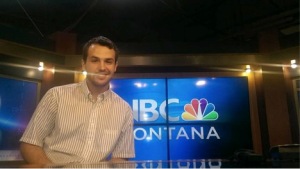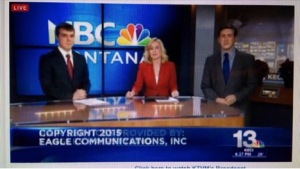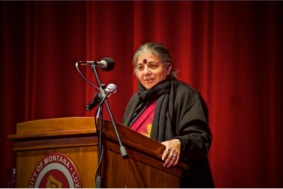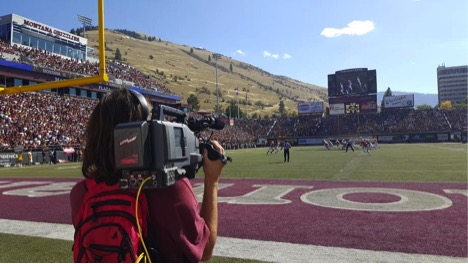One day in JRNL 100, Mason Birgenheier stood in front of the class and announced that KPAX-TV was looking for production help. He had been working afternoon shifts at the station, serving as a production assistant, when Ethaniel Fitzgerald heard his announcement. Fitzgerald soon landed a position at KPAX, helping manage and produce The Morning Show, clocking in at 3am and then leaving straight from work to go to class.
 Now, three years later, both Birgenheier and Fitzgerald have won NATAS scholarships for their dedication to the broadcast industry.
Now, three years later, both Birgenheier and Fitzgerald have won NATAS scholarships for their dedication to the broadcast industry.
The goal of the National Academy of Television Arts & Sciences (NATAS) scholarship program is to support promising students in their pursuits in the television field of journalism. As part of the award, winners travel to Seattle, Washington in June for further recognition and to go behind the scenes in a larger newsroom.
The UM School of Journalism has a long history of broadcast majors receiving NATAS scholarships. Of this year’s winners, Ray Ekness, Professor & Director of Student Success, said, “Both Ethan and Mason are exactly what the NATAS folks are looking for. They’re smart, take feedback well, are willing to learn and have been working hard at local television stations.”

Currently, Birgenheier and Fitzgerald work for KECI-TV, a local subset of NBC. Birgenheier mostly focuses on the production side and said that the team’s atmosphere revolved around the word ‘hustle.’ “It’s so fast-paced and you’re constantly on your toes,” he said. “But when something happens, you’re the first ones to know.”
As someone who grew up in Missoula, Birgenheier said that he enjoyed using his technological skills to keep people up to date with the local news. “I like knowing what’s going on in my community,” he said.
While Fitzgerald also has substantial production experience, lately he’s been working as KECI’s weekend sports reporter. He said the position functioned at a different pace than the news, but it was still fun and exciting.
Fitzgerald won NATAS’s specific Tricia Moen Scholarship, which emphasizes the producing and writing aspects of broadcast journalism. This scholarship honors Tricia Moen, a producer at KOMO-TV in Seattle, who continued to work even after being diagnosed with Stage-4 cancer. During the NATAS application process, Fitzgerald researched her story and felt touched by her journey. “I had goosebumps,” Fitzgerald said. “I wanted to be better at my job because of her.”
Yet Fitzgerald’s inspiration at the J-school came from Ekness, who gave him technical advice and pushed him to be a better journalist. “He’ll do anything for his students,” Fitzgerald said.
Birgenheier agreed. “I’m thankful to a lot of people, but especially Ray,” he said. “I owe a huge kudos to him.”
“I’m very proud of what they’ve accomplished,” Ekness said. “I’m looking forward to the great things they’ll do in the future.”
For Fitzgerald, the future revolves around finding a news team that works well together. “I like anchoring and being behind the scenes,” he said. “I want to have a lot of skills, and [someday] I’d like to just be able to roll the dice and go there.”
When Birgenheier started at UM, he didn’t see himself as a journalist. “But now that I’ve found it, I know it’s always been a part of me, “ he said. “I hope to anchor someday, and I feel more confident after winning this scholarship. It’s taken a lot of hard work to do this and to feel like someone actually noticed, is awesome.”
As both students head into their senior year, they plan to keep working at KECI and gain as much experience as possible from their jobs and from their classes. In 2016, the UM School of Journalism was ranked top-ten in the nation, and Birgenheier felt obligated to keep that reputation strong.
“We’re pretty good at what we do,” he said. “It’s up to us to carry the torch.”
Missed the 6 o’clock news? Follow Mason Birgenheier on Twitter, Instagram or the Montana Race Project for his contributions to local stories, and follow Ethaniel Fitzgerald on Twitter to catch up with the latest news in Missoula.
By Jana Wiegand


